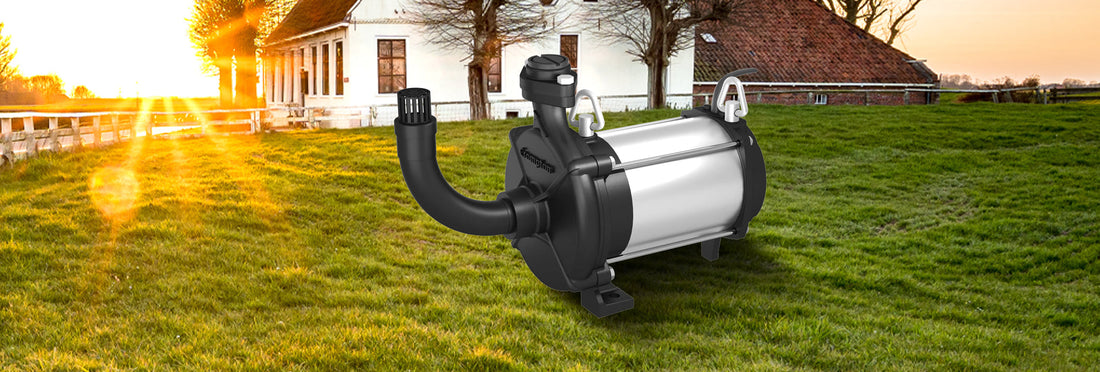Here’s Everything You Need To Know About Submersible Water Pump Wattage


Submersible water pumps are designed for underground operation, akin to the sump pumps found in numerous homes. These pumps require complete submersion in liquid to function effectively. In contrast to surface-level pumping systems that draw water from the ground, submersible pumps are engineered to propel water upwards to the surface.
These pumps come in various sizes, with two primary types being utilised for delivering potable water: shallow-well and deep-well pumps. A standard submersible well pump is a cylindrical device, measuring between 2 to 4 feet in length and 3 to 5 inches in diameter. This cylinder houses a hermetically sealed motor, closely integrated with the pump's body. The motor's sealing is crucial to prevent water ingress, which could lead to electrical short circuits. The motor operates an impeller. Upon activation by a pressure switch, the impeller starts rotating, pulling water into the pump. The water is then forced through the pump's body and up to the surface. Additionally, the system includes a cable linked to the motor and a pipe that channels the water to the surface and into a storage tank.
The pump's size is determined by the well's yield and the household's water requirements. It is essential to choose a pump that can handle the peak demand of the household, rather than just the average usage. A critical guideline is to avoid installing a pump with a capacity exceeding the well's output unless utilising well storage is necessary to meet peak demands.
How Do You Check Submersible Pump Wattage?
Submersible and above-ground pumps typically bear a label when they are clean and new. This label contains vital information such as the motor's horsepower or kilowatt rating, the expected amperage draw, and the required voltage for proper operation. Locating this label on an above-ground pump is generally a straightforward task, taking only a few seconds. However, for submersible pumps, which are often situated hundreds of feet underground, the process requires more effort.
Submersible pumps are usually connected to a control box, where the well's wiring converges. This control box often displays the label on its exterior. However, some manufacturers or installers may place detailed information inside the box. To access such internal labels, one might need a screwdriver to remove the cover of the control box. It is strongly recommended to disconnect the power to the pump before removing any electrical covers. Always adhere to proper electrical safety protocols when handling any electrical equipment.
How Do You Calculate The Wattage Of Your Submersible Well Pump?
Specify the average number of hours your Water Pump operates each day. For durations less than an hour, use a decimal format. For instance, 30 minutes would be entered as 0.5, and 15 minutes as 0.25.
- Pump power consumption (Watts): Enter the wattage of your Water Pump. Water pumps will usually have a reading.
- Typical wattage of a water pump: The amount of electricity consumed by a water pump is determined based on the make, size, or other characteristics of your device. You can usually find your Water Pump's wattage in its user manual or directly on the unit.
- Electricity Rate: Input your electricity cost per kilowatt-hour (kWh). If you’re not sure, then check the average electricity consumption in your area. Remember rates are different in different states, and this also depends on your electricity-providing company.
Benefits Of Submersible Well Pumps
Here are some of the advantages of submersible well pumps
- Reduced mechanical failures: Submersible pumps experience fewer mechanical issues compared to surface pumps, making them more reliable.
- Longer lifespan: These pumps can last up to 25 years before needing replacement, offering long-term service.
- No prime loss: Unlike above-ground pumps, submersible pumps don't lose their prime, which prevents motor burnout and the need for frequent replacements.
- Cavitation resistance: Submersible pumps are not susceptible to cavitation problems, a common issue in above-ground pumps, due to their deep underwater placement.
- Efficient water delivery: They provide an efficient means to transport water from the well to the home, ensuring a consistent water supply.
- Low maintenance: Submersible pumps require relatively less maintenance, making them a hassle-free option for water supply needs.
Functioning Of A Submersible Pump
Curious about the operational mechanics of a submersible pump? Here is an insightful explanation.
Fully immersed in water, the submersible pump's role is to elevate water to the surface. Water enters the pump from the well or reservoir through the foot valve and encounters the impeller having multiple fixed blades. This impeller is linked to an electric motor by a shaft and spins in sync with it. When water hits the impeller blades, they transform the water's kinetic energy into velocity, thus accelerating the water flow. Post-impeller, the water flows into the diffuser which converts this velocity into pressure energy. Consequently, the diffuser amplifies the water pressure, and this high-pressure water is then expelled through the pump's outlet valve. This process enables the submersible pump to effectively push water to the surface.
Selecting The Ideal Submersible Well Pump For Your Home
A submersible well pump is a vital part of your home's plumbing system, essential for delivering water. Choosing a pump that meets your specific needs and adapts to your local area's conditions is crucial. In addition, accurately determining your well’s depth is also essential when shopping for a submersible well pump. Here are some key points to assist you in finding the perfect pump for your residence.
- For wells with a depth of up to 25 feet, a shallow jet pump is a suitable choice to guarantee a consistent water supply.
- For wells that are between 25 and 110 feet deep, a deep jet pump is the better option to ensure a steady flow of water.
- If you have a well that is between 110 and 400 feet deep, a four-inch submersible pump is recommended for a reliable water source.
Priming Your Submersible Well Pump
A submersible well pump is a simple yet effective device that can be tailored to the needs of your property. Be mindful that too much water pressure can damage the pump, so it's important to prime it correctly before use.
Priming is the process of removing air from a pump and suction line. The pump is filled with the liquid that needs to be pumped and air or gas is forced out of the passageways.
To prime the pump, disconnect it from all electrical sources. Remove the prime plug and open the release valves to avoid pressure buildup. Then, attach a hose to the well pump's opening where the prime plug was. Fill the pump with water, prime it, and then replace the prime plug before reconnecting the pump to electricity.
Choosing The Right Size Submersible Well Pump
The size of your well is an important consideration when selecting the right pump. The number of people living in your home and your typical water usage, including appliances like dishwashers or washing machines, should also be considered.
Takeaway
Submersible well pumps are pivotal in efficient underground water extraction. Their selection demands thorough consideration of the well’s depth and the household's water demand to ensure efficient and enduring functionality. The key to this process is determining the pump's wattage, typically accessible via the label on the control box, and considering the circuit breaker size and generator capacity for optimal performance. Additionally, consistent maintenance, correct priming of the pump, and appropriate usage are recommended to ensure a steady, reliable water supply for a long time.
About Crompton’s Submersible Pumps
Crompton's submersible pumps are an excellent choice for water supply systems. Renowned for their energy efficiency and robust durability, they stand out as a smart choice. Each pump is equipped with a power consumption metre, providing valuable insights into energy usage, thus enabling cost-effective operation. Additionally, their design, featuring a 4-wire cable, simplifies installation, making them user-friendly. These pumps are versatile and adept for various applications like water supply, sewage management, firefighting, and water treatment. Choosing Crompton's pumps guarantees not only a reliable water solution but also a commitment to quality and sustainability.
Get steady water supply whenever you need with Crompton submersible pumps. Explore your options today!
FAQs on Submersible Pumps
-
What advantages does a borewell motor offer?
A borewell motor brings several advantages. These include ease of portability and convenience, remarkable efficiency, resistance to corrosion, the ability to self-prime, versatility in application, and a straightforward installation process. -
How do borewell submersible pumps differ from open-well submersible pumps?
Borewell submersible pumps are composed of an alternating current (AC) electric motor, an impeller, a cable guard, a diffuser, and an electrical cable. In contrast, open-well submersible pumps are set up on the base of an underground tank or reservoir and require an electrical connection for their operation. -
Which submersible pump is recommended for a 200-feet head in agricultural use?
For agricultural activities at a 200-foot head, an open submersible water pump with a 1.5 horsepower (Hp) rating is suggested. -
What are the optimal open well submersible pump choices for agriculture?
For agricultural purposes, the two most effective types of open-well submersible pumps are the horizontal and vertical models. -
Which is better, a submersible pump or centrifugal pump?
Note that submersible pumps and centrifugal pumps, although pump liquid, have different applications. For instance, submersible pumps are used to pump water from deep wells as well as in mining, aquaculture and fisheries. A centrifugal pump is mainly used for irrigation, dewatering during excavation and foundation work or aqua farming. -
Can submersible pumps cause electric shocks?
Submersible pumps are intended for water bodies that are not routinely accessed by humans. You should never swim in a water body with a submersible water pump. Even though submersible pumps are designed with numerous safety features, water + electricity is a dangerous combination.

 Read Previous Blog
Read Previous Blog


 at 9228880505 or write to us at
at 9228880505 or write to us at 